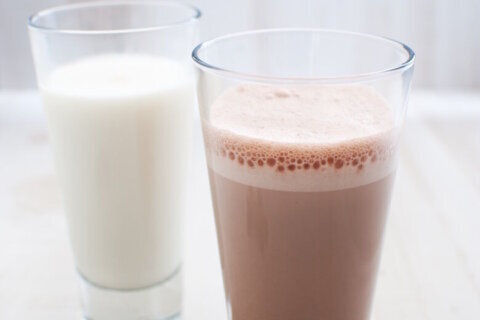With the official start of summer less than 10 weeks away, it’s time to say goodbye to your favorite winter comfort foods — and your not-so-favorite winter weight. To do that, take these five tips from top registered dietitians:
1. Tidy your kitchen.
A behavioral study published in the journal Environment and Behavior reported that women who had disorganized kitchens ate more than twice the calories — and gobbled up more sweets — than women in neater kitchens. The investigators believe that chaotic surroundings can cause anxiety, which tends to turn on the hunger switch. Furthermore, additional research from the same scientists at Cornell University concluded that leaving food on kitchen countertops can also result in overeating.
To avoid this problem, declutter your kitchen cabinets while you’re spring-cleaning the other closets, drawers and shelves in your home. Start by giving the pantry, refrigerator and freezer a once-over, and then throw out or donate the foods that are sabotaging your wellness goals. Lastly, organize the spaces by placing the healthiest items at eye level. “Keep any binge-worthy foods out of sight and line the countertops with fresh fruits or veggies, which will encourage you to eat more of them,” says Katherine Brooking, a registered dietitian who co-founded Appetite for Health with me.
[See: 6 Ways to Train Your Brain for Healthy Eating.]
2. Eat seafood, not steak.
Most Americans consume way too much animal-based protein and way too little seafood, with only 1 in 10 Americans meeting the minimum recommendations for seafood in their diets. But upping your seafood intake seems to be important if you want to live a longer, healthier life. In fact, a study of nearly 100,000 adults published in JAMA reported that participants who ate a primarily plant-based diet with fish — but no meat — lived longer than vegans who ate only plant-based foods. Research shows that fish-rich diets can help defend against heart disease, Type 2 diabetes, obesity and other chronic conditions.
The 2015-2020 Dietary Guidelines for Americans recommends eating at least two seafood meals (a total of 8 ounces) per week to consume adequate beneficial DHA and EPA omega-3 fatty acids. Pregnant and breastfeeding women need even more — three servings a week — to obtain enough essential omega-3s to promote healthy brain and eye development. In order to meet my weekly seafood quota, I eat a salmon burger, fish tacos, spinach-stuffed sole or other seafood-based meals several times a week.
[See: 13 Best Fish: High in Omega-3s — and Environmentally-Friendly.]
3. Squeeze in more veggies.
Here’s another startling statistic: Nearly 9 out of 10 Americans don’t eat enough vegetables, according to research from the National Cancer Institute. Since veggies are calorie-poor and nutrient-rich, they should be the foundation of your diet.
Start your day off with a healthy kick by adding at least one member from this powerhouse food group into a breakfast smoothie, advises Jennifer McDaniel, a registered dietitian and spokeswoman for the Academy of Nutrition and Dietetics. Her on-the-go recipe includes two cups of spinach, half a banana, a half-cup of blueberries, a tablespoon of ground flaxseed and a tablespoon of nut butter. She puts the ingredients in freezer bags at night and throws them in a blender with milk in the morning. “Within seconds,” she says, “I have a smoothie that has three servings of produce.” Another option: Eat an egg-based breakfast twice a week (frittata, anyone?) and add your favorite veggies into the frying pan.
4. Lick your sweet tooth.
How much sugar is too much? The American Heart Association recommends no more than 6 teaspoons (100 calories) of added sugar daily for women and no more than 9 teaspoons (150 calories) for men each day. (If you’re reading a food label and trying to calculate how much of the sweet stuff is in a food or beverage, know that 4 grams of sugar equals 1 teaspoon of sugar.)
If you find that sugar is your diet’s Achilles’ heel, you can appease your sweet tooth by choosing guilt-free foods with natural sugars like fruits (including dried fruit), veggies and dairy foods. Keep in mind that when you indulge makes a difference as well. Gummies (as well as bread, pasta and other carb-rich choices), for instance, should be eaten after a protein, fat or fiber. Studies show that doing so can help delay and temper the release of sugar into your bloodstream, minimizing their negative impact on your health.
5. Perfect your portions.
Since most portions you’re served are ginormous, it’s harder than ever to determine a healthy serving size. And as a result, we overeat and wonder why we can’t lose weight. “To stay on track, I keep my portion sizes in check by using measuring spoons and cups when serving myself,” says Marina Chaparro, a registered dietitian and spokeswoman for the Academy of Nutrition and Dietetics. Follow her example by making an effort to weigh and measure your food for the next seven to 10 days.
[See: 10 Healthy Habits of the ‘Naturally’ Thin.]
You can also minimize portions by using a tablespoon to dress your salad instead of pouring oil or salad dressing on straight from the bottle. Another great idea is to pile half your plate with fiber-rich veggies, which not only provide volume, but will also help keep you feeling fuller longer on fewer calories. And yes, size does matter: Research shows that eating meals from smaller plates and bowls can actually fool your brain into feeling satisfied on less food. In fact, one study from Cornell University reported that reducing your plates from 12 inches to 10 can reduce the calories you eat by 22 percent. Bon appetit!
More from U.S. News
10 Unusual Weight-Loss Tips That Actually Work
7 Ways to Hack Your Grocery Trip for Weight Loss
9 Ways to Actually Make Eating Well Fun This Summer
Spring Clean Your Diet With These 5 Simple Hacks originally appeared on usnews.com







